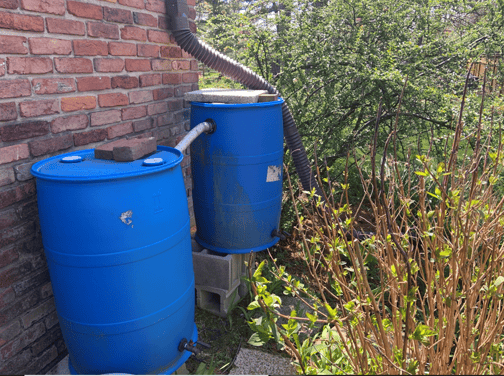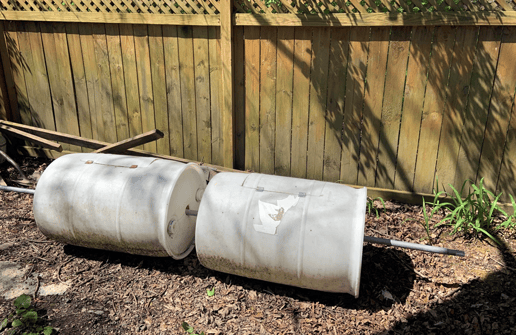At work, I’m a member of Melink’s Sustainability Committee. We are a group of approximately 10 employee-owners working toward community involvement and education related to sustainability. Our team focuses on initiatives like ensuring our fellow Melinkers are educated on recycling and composting best practices. We conduct a monthly waste audit at our facility. We’ve set up initiatives to recycle items that typically aren’t recyclable, like toothpaste tubes and Plastic #5 items. Being part of the committee made me wonder how I could incorporate sustainability into my home life, too.
I began thinking of ways to add green infrastructure to my house. Based off electricity stats sent by my utility company, my house is ranked among the most energy efficient in the area. So instead of thinking inside my house, I wanted to “green” aspects on my home’s outside.

DIY Rain Barrel
So, I decided my first project (thanks to YouTube university) would be a set of three 55-gallon rain barrels to use in the summer when Cincinnati goes through its driest months. Full disclosure: Making a rain barrel is noted on most DIY sites as an easy project. I am not a handy person; I had never picked up a drill before this, and I was able to complete the project in about a day.
Rain barrels are an interesting project because there are many options. There are kits sold at home improvement stores, or you can reuse food-grade 55-gallon drums as an inexpensive alternative. With sustainability in mind, I went for the reusable option and was able to buy my drums online from a soy sauce wholesaler for around $10. Also, I purchased spigots to install on the barrel to give us the option to use a drip hose on especially dry days.
I use the collected water for watering my lawn, vegetable garden, and hanging flower baskets. I haven’t noticed a return on our water bill, but I do feel less guilty watering my lawn and garden when I’m using water from the barrels.
However, having large, blue barrels near our downspouts is not the most aesthetically pleasing look for our backyard. Before starting this project, especially if you live in a neighborhood, check to see if there are any restrictions. I followed our subdivision’s guidelines by installing the barrels on the back side of the house behind a fence. Make sure to reach out to your local officials to confirm any guidelines on water capture.
If you’re ready to get started, I recommend this video.

DIY Compost Bin
Since the rain barrels were so easy to make, I decided to step up my green infrastructure game with a second project. We already had a couple of compost boxes, but I wanted to try building rolling compost containers. This project required a few more tools but was also very simple.
If you’re a gardener, composting is a great way to boost your soil and, ultimately, your harvest. Composting enriches the soil by helping to retain moisture and suppressing plant diseases and pests. It reduces the need for chemical fertilizers.
I made two rolling compost bins, using two additional barrels I purchased online. I am able to move them around the yard to add compost to our vegetable garden and potted plants. Compost is the “black gold” of soil. My vegetables grow really well with the compost, and there is almost no need to use any fertilizer.
This video gives a nice overview on how to build your own compost bin.
My Future Home Sustainability Projects
The great part about both of these home sustainability projects was how I was able to reuse items. Materials that might be deemed “trash” or unwanted were saved from going to the landfill. I was able to build both projects with materials I had around the house or from the barrels that had already served their purpose.
What’s next? During my time in the Peace Corps, I focused on community gardening and that is something I would like to revisit now. I think my next project will be a raised vegetable garden — maybe a keyhole garden with compost in the middle.
